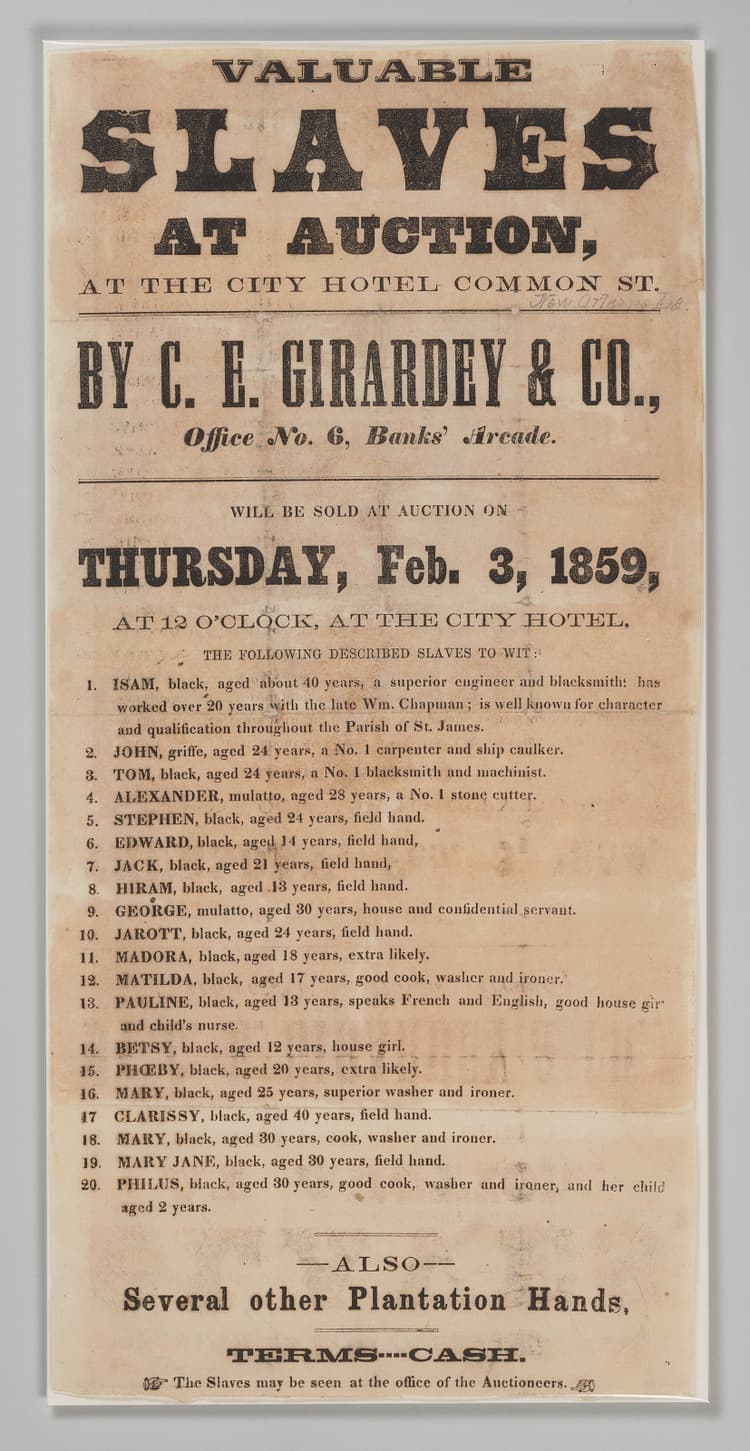Labor, Culture, and Economy
Zoe Green
8 min read
Listen to this study note
Study Guide Overview
This study guide covers the labor and skills of enslaved people, including various labor tasks (domestic, agricultural, skilled), institutional enslavement, and the commodification of skills. It also examines different labor systems (gang vs. task) and their impact on cultural practices such as work songs and language preservation (Gullah). The guide further explores the economic impact of slavery, including North-South interdependence and resulting wealth disparities. Finally, it provides practice questions and exam tips, emphasizing the connections between these key topics.
#AP African American Studies: The Night Before Review 🚀
Hey! Let's make sure you're feeling awesome and ready to crush this exam. We've got this! 💪
#1. Labor and Skills of Enslaved People
#Variety of Labor Tasks
- Enslaved people performed a wide range of jobs, regardless of age or gender. Think of it like a full spectrum of work! 🌈
- Domestic Work: Cooking, cleaning, childcare 🏠
- Agricultural Work: Planting, harvesting, livestock care 🧑🌾
- Skilled Labor: Blacksmithing, carpentry, tailoring 🔨
- Roles varied by location, with some enslaved people bound to institutions like churches, factories, and colleges. 🏢
- Many enslaved Africans brought valuable skills from Africa that enslavers exploited. 💡
- Examples: Blacksmithing, basket-weaving, rice & indigo cultivation.
- African Americans developed specializations (painters, carpenters, tailors, musicians, healers) that enslavers commodified.
- Despite commodification, these skills were used for survival, culture, and community. ✊
#Domestic vs. Agricultural Labor
- Domestic Labor: Tasks within the household. 🧺
- Cooking, cleaning, childcare.
- Agricultural Labor: Farming and plantation work. 🚜
- Planting, harvesting, tending to livestock.
#Institutional Enslavement
- Enslaved people bound to institutions (churches, factories, colleges) rather than individuals. 🏛️
- Often involved specialized labor tasks specific to the institution.
- Maintaining church grounds, factory work, college campus labor.
#Skills and Commodification
- Enslaved Africans brought valuable skills that enslavers exploited. 💰
- Blacksmithing, basket-weaving, rice & indigo cultivation.
- African Americans developed specializations that enslavers commodified.
- Painting, carpentry, tailoring, music, healing.
- These skills were used for survival, culture, and community.
Enslaved people's labor was diverse and crucial to the economy, yet they were denied its benefits. This is a key point for understanding the legacy of slavery.
#2. Slave Labor and Cultural Practices
#Gang vs. Task Systems
- Gang System: Enslaved people worked in groups from sunrise to sunset under supervision. ☀️
- Used for crops like cotton, sugar, and tobacco. 🌿
- Led to the creation of work songs with syncopated rhythms. 🎶
- Task System: Enslaved people worked individually until a daily quota was met, with less supervision. ⏰
- Used for crops like rice and indigo. 🌾
- Allowed for the preservation of linguistic practices, like the Gullah language.
#Work Songs and Rhythms
- Work songs with syncopated rhythms helped coordinate labor and fostered unity. 🎵
- These songs expressed the hardships and emotions of enslaved life. 😥
#Linguistic Practices Preservation
- Gullah creole language developed in the Carolina lowcountry, combining West African languages and English. 🗣️
- Preservation of language allowed for connection to heritage, communication, and cultural transmission. 🌍
Gang = Group work, Task = Time-based. Remember the 'G' for group, and 'T' for time to differentiate the two systems. Also, Gang system often resulted in Group songs, and Task system allowed for Traditional language preservation
#3. Economic Impact of Slavery
#North-South Economic Interdependence
- Slavery created economic interdependence between the North and South. 🤝
- Northern cities benefited from the slave economy through:
- Textile mills processing cotton. 🏭
- Banks providing loans to Southern plantations. 🏦
- Merchants trading goods produced by enslaved labor. 🚢
#Slavery's Role in the Economy
- Enslaved labor was the foundation of the American economy. 🏗️
- Despite their essential role, enslaved people were alienated from the wealth they produced. 💔
- Cash crops, infrastructure, and skilled labor all relied on enslaved people.
#Wealth Disparities from Slavery
- Slavery entrenched racial wealth disparities that persist today. 📉
- Enslaved people had no wages, no property rights, and no ability to accumulate wealth. 🚫
- This lack of wealth accumulation led to long-lasting economic inequalities.
- Lower homeownership, reduced access to education, and income gaps.
This section is super important! Understanding the economic impact of slavery is crucial for both MCQs and FRQs. Make sure you know the connections between North and South and the long-term effects on wealth disparities.
#4. Required Sources: Visuals and Insights
#Sugar Cane Harvest, Antigua, West Indies 1823, 1826

- Caption: This image shows the harsh labor of enslaved people harvesting sugarcane, a key crop in the transatlantic slave trade. It highlights the brutal conditions and the human cost of the sugar industry.
#Broadside Advertising "Valuable Slaves at Auction" in New Orleans, 1859

- Caption: This broadside demonstrates the dehumanization and commodification of enslaved people, treating them as property to be bought and sold. It reveals the cold, business-like nature of the slave trade.
#Rice Fanner Basket, Circa 1863

- Caption: This rice fanner basket represents the agricultural skills and forced labor of enslaved African Americans in the South. It highlights the contributions of enslaved people to American agriculture and the complex relationship between African traditions and exploitation.
#5. Final Exam Focus
#Highest Priority Topics:
- Economic Impact of Slavery: Understand the interdependence between North and South, and the long-term wealth disparities. 💰
- Labor Systems: Know the differences between gang and task systems, and their impact on culture. 🧑🌾
- Cultural Practices: Be familiar with work songs, syncopated rhythms, and the preservation of linguistic practices like Gullah. 🎶
- Commodification of Skills: How enslaved people's skills were exploited and how they used them for survival and community. 🛠️
#Common Question Types:
- Multiple Choice: Expect questions that test your understanding of specific labor systems, economic relationships, and cultural practices. 🤔
- Short Answer: Be prepared to explain the impact of slavery on the economy, or the ways enslaved people preserved their culture. ✍️
- Free Response: You might be asked to analyze primary source documents (like the images above) or to discuss the long-term effects of slavery on American society. 📝
#Last-Minute Tips:
- Time Management: Don't spend too much time on one question. If you're stuck, move on and come back later. ⏱️
- Common Pitfalls: Avoid generalizing. Be specific and use evidence from the course material. ⚠️
- Strategies: Read the questions carefully, underline key terms, and plan your answers before you write. ✅
Remember to connect different units! AP questions often combine multiple concepts, so think about how labor systems relate to economic impacts and cultural practices. Use the required sources as evidence in your FRQs.
#6. Practice Questions
Practice Question
Multiple Choice Questions
-
Which of the following best describes the task system of labor used in the antebellum South? (A) Enslaved people working in large groups under constant supervision (B) Enslaved people working individually until a daily quota was met (C) Enslaved people working in rotating shifts throughout the day and night (D) Enslaved people working primarily in domestic settings with minimal oversight
-
How did the economic system of slavery contribute to wealth disparities in the United States? (A) By providing equal opportunities for all races to accumulate wealth (B) By enabling enslaved people to earn wages and pass down property (C) By creating a system where enslaved people produced wealth but were denied its benefits (D) By ensuring that all profits from agricultural production were distributed equally
Short Answer Question
Explain how the gang system and the task system of labor influenced the cultural practices of enslaved people in the antebellum South. Provide specific examples in your response.
Free Response Question
Analyze the economic impact of slavery on the United States, considering both the North and the South. In your response, discuss how slavery fostered interdependence between the regions and how it contributed to long-lasting wealth disparities. Use the provided images and your knowledge of the course to support your analysis.
Scoring Breakdown for FRQ
- Thesis (1 point): A clear thesis statement that addresses the economic impact of slavery on both the North and South.
- Economic Interdependence (2 points): Explanation of how the North benefited from the slave economy (textile mills, banking, trade) and how the South relied on enslaved labor for agricultural production.
- Wealth Disparities (2 points): Discussion of how slavery created wealth for enslavers and their descendants, while denying enslaved people and their descendants the ability to accumulate wealth. Mention the lack of wages and property rights.
- Use of Sources (2 points): Analysis of the provided images to support the argument. For example:
- The image of the sugar cane harvest shows the brutal labor that fueled the economy.
- The broadside demonstrates the commodification of enslaved people, highlighting their role as economic assets.
- Synthesis (1 point): Demonstrating an understanding of the long-term economic consequences of slavery and its lasting impact on racial wealth disparities in the US.
You've got this! Go get 'em! 🌟
Continue your learning journey

How are we doing?
Give us your feedback and let us know how we can improve





